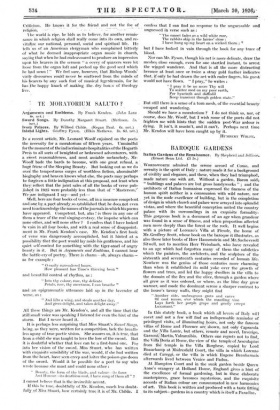BAROQUE GARDENS
Italian Gardens of the Renaissance. By Shepherd and Jellicoe. (Ernest Beim Ltd. £5 5s.) ' • - WORDSWORTII admired the serene accord of ,Conio, and serenity is the spirit of Italy ; nature made it for a background of civility and' elegance, and these, when they had triumphed, made nature one with art. Without a garden, Bacon said; " buildings and palaces are but gross handyworks " ; and the architects of Italian humanism expressed the fineness of the human spirit neither in a communion with wild nature, nor yet, in the nude excellence of building, but in the completion of design in which church and palace were arrayed into splendid vistas, and where the beautiful conception united the country palace with its surroundings in an exquisite formality. This gorgeous book is a document of an age when grandeur was found in a sense of fitness, and when proportion affected men more deeply than the forest or the rock. It well begins with a picture of Lorenzo's Villa at Fiesole, the home of Mr. Geoffrey Scott, whose book on the baroque it illustrates, as also those later books of Herr Hausenstein and Mr. Sacheverell Sitwell, not to mention Herr Weissbach, who have revealed to an age which had forgotten many of them the subtleties which the painters, the architects, and the sculptors of the sixteenth and seventeenth centuries recorded of human life. Nowhere was the genius of those centuries more charming than when it established its mild yoke over the growth of flowers and trees, and led the happy dwellers in the villa to the domain of the ilex and the olive, through a garden where all grew as it was ordered, or where, as the blue day grew warmer, and made the dominant serene a sharper contrast to the house's tawny walls, they might find
" Another aide, umbrageous grots and caves Of cool recess, o'er which the mantling vine Lays forth her purple grape and gently creeps Luxuriant."
In this stately book, a book which all lovers of Italy will covet and not a few will find an indispensable reminder of privileged visits, of illuminating honrs, not only the famous villas of Rome and Florence are shown, not only Caprarola and theyilla Lante, but others, demote and novel, Inverigo, Garzonir-Martia, Valzanzibio. Others one regrets not to find, the Villa Doria at Rome, the view of the temple of Aesculapius from the temple in the Villa Borghese, copied by Lord Beauchamp at Midresfield Court, the villa in which Lorenzo died at Careggi, or the villa in which' Eugene Beauharnais afterwards lived between Venice and' Padua.
At Hampton Court and in the sunk garden beside Queen Anne's orangery at Holland House, England gives a hint of the excellence of formal gardening, but in these elaborate masterpieces, grace becomes mysterious, and, the exquisite accords of Italian colour are. consummated in new harmonies of art. This book is written and produced with a taste fitting to its subject—gardens in a country which is itself a Paradise.


























































 Previous page
Previous page